Comparison of electronic voltage regulators of foreign (Chinese) and Russian production
Currently, the question of the need and choice of a voltage regulator is becoming increasingly difficult. In the market appeared inexpensive On-line UPS, able to partly replace the functions of the stabilizer (work in a wide range of voltages, well tolerate overload). However, our domestic and industrial networks often destroy even the UPS due to overvoltages and other factors. Therefore, the use of voltage stabilizers to protect equipment (and the same UPS) is still quite relevant.
Samples of fairly common RESANTA relay stabilizers, a Chinese stabilizer TDR-10000 of a little-known company, bought on an Alibaba and a Russian-made stabilizer of the SCM series were selected as a review product. Other types of stabilizers ( thyristor , motor-drive , etc.) were not taken for comparison, because, first, we compare what we have on hand, and second, their comparison can turn into another “holivar”. Each type of stabilizer has its own advantages and disadvantages. Choice is always a compromise.
The fact that stabilizers perform their main function is not questioned, otherwise they would not be sold - they all maintain the output voltage in a given range. Therefore, we will select the following comparison criteria: comments on the parameters; appearance; quality of installation and accessories; protection, electrical safety and fire safety, additional functions.
The first thing that catches your eye when reading the instruction manual is a load characteristic. It turned out that, for example, for our stabilizer ASN-8000/1 at a voltage of less than 200 V, the permissible output power is linearly reduced from 8 kVA to 4 kVA. This unpleasantly surprised (and, in accordance with the instruction manual, the manufacturer imposes on the consumer the choice of a deliberately more powerful stabilizer, otherwise it is removed from the guarantee). Indeed, according to the standard (Clause 5.2 of GOST 13109-97), the maximum permissible deviation of the mains voltage from the nominal is 10% (198-242 V). Those. at a voltage of more than 200 V, the stabilizer is not particularly necessary (you can do with a power protective relay). And at a voltage of less than 200 V, you need to take into account the permissible power that is below the maximum. In the manual, this is due to the increase in the input current of the stabilizer. The only way to explain this in fact is the deliberately overestimation of the output power for advertising purposes, since this problem is solved by increasing the size of the autotransformer - and this is extra dimensions and money.
The second is regulation time. Sly manufacturers specify the regulation time as the relay contact time, and even then, the indicated 5 ms does not correspond to reality. The actual switching time of the relay (from the moment when the voltage is applied to the coil to contact closure) is not less than 7 ms for the relays of the best manufacturers: Omron, Tyco, Hongfa, TTI (at one time I accelerated from 15 ms to 4.5 ms to switch the polarized GRUNER relays applying an overvoltage control at the start of the switch - but this is extremely detrimental to the service life of the relay), plus the response time of the control system - for control of the actual voltage value, it is at least 3-5 ms (a quarter of the mains voltage).
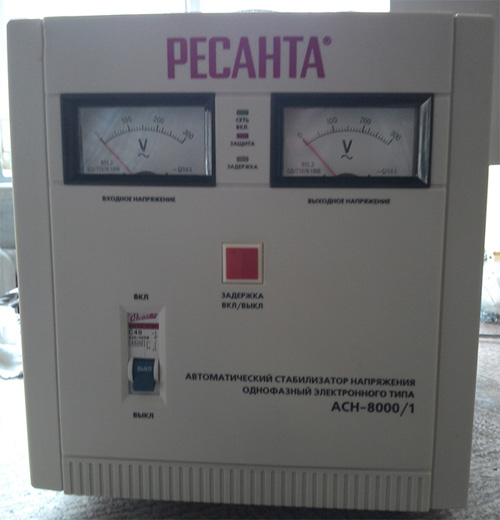
')
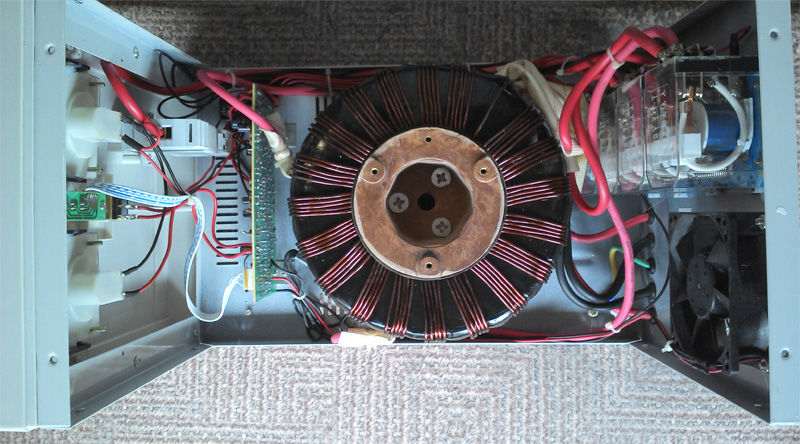
Pumped up also installation of conductors to the relay. The installation was done by soldering, not quite neatly, but the main thing - it works.

Relays in the stabilizer are installed JQX-40F. The manufacturer on the case is not listed, but many manufacturers make such relays. The relays are rated at 40A, which is quite enough for 8 kVA load.
No current measuring circuit was found in the stabilizers. From which it can be concluded that there is no automatic overload protection - there is only hope for the built-in automatic switch and protection against overheating. In addition, the principle of relay switching remains unknown: when a current passes through zero, zero voltage, or at an arbitrary point in time, the life of the relay depends on it.
The output protection against input voltage exceeding is declared by the manufacturer at the level of 260 V. Although the limit value of the voltage at which the stabilizer itself does not fail, remains unclear.
Upon further inspection of the viscera, it was found that the stabilizers do not contain any elements of filtration and protection against impulse overvoltages (GOST R 51992-2002).
In the powerful stabilizers applied forced cooling (not very effective, but sufficient). On the one hand, this facilitates the modes of operation of the stabilizer components, and on the other, it is an activated and noisy fan, which over time will require maintenance.
In addition, the stabilizers display the value of the voltage at the input and output (switch instruments in previous models and digital indicators in the current on the market).
Summarizing, we can note the main features (both positive and negative) of the RESEARCH stabilizers:
1) You need to buy stabilizers with at least 40% power margin
2) Stabilizers are composed of the main elements of fire safety and protection
3) The stabilizer is likely to protect the connected equipment from long-term overvoltages, although it may also fail.
4) In the stabilizer there are no filtering elements of the mains voltage and elements of protection against surge overvoltages.
5) Stabilizers are incredibly cheap. In Russia, only one transformer for the same power as the RESANTA stabilizer costs half its price.
The stabilizer was purchased in China and delivered by EMS (the same stabilizers can be found in Russia). The cost is 30% less than the RESANTA stabilizer.
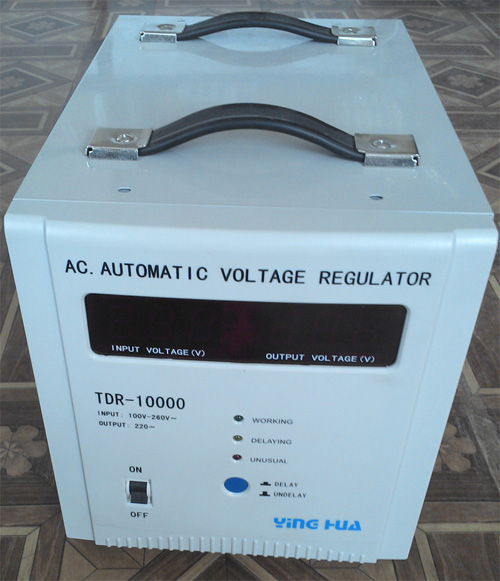

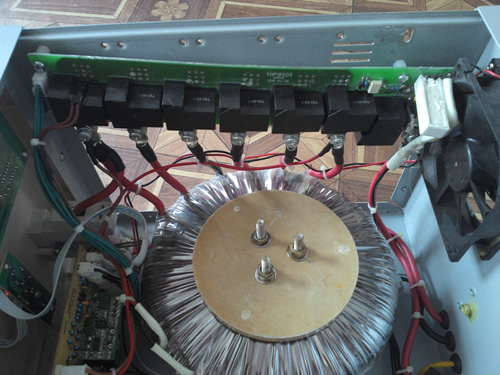
Apparently, there were not enough wires from the transformer, plus the bottom was dragged out.
The mounting of the printed circuit board and the installation of capacitors are similar to RESENTANT stabilizers.
Upon further examination, it turned out that in the stabilizer the “no-name” relays were installed, similar to the TR90 (TTI) or HF2150 (HONGFA) rated current 30A. Those. the maximum switching power of the relay is 6600 VA, there can be no talk of any declared 10,000 VA.
Therefore, a further description of the stabilizer is meaningless.
The stabilizer was turned on, it looked like the input and output voltage shows (quite accurately), turned off and removed away.
Conclusion - no need to chase for cheap.
In the presence of a stabilizer SCM-6000, so the conversation will go about it.
The stabilizer provides its parameters , including the declared rated output power in the entire supply voltage range (the lower range is slightly higher than the RESPECT stabilizers for the same reason for increasing the input current).
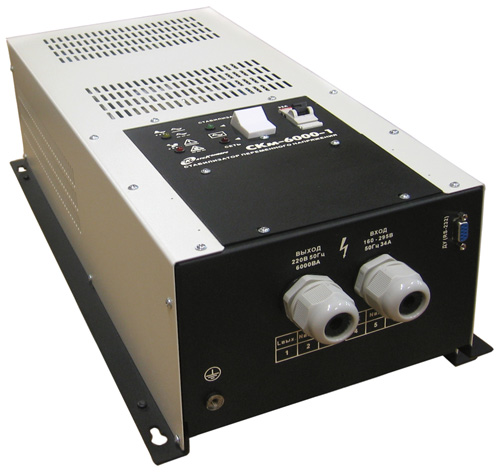
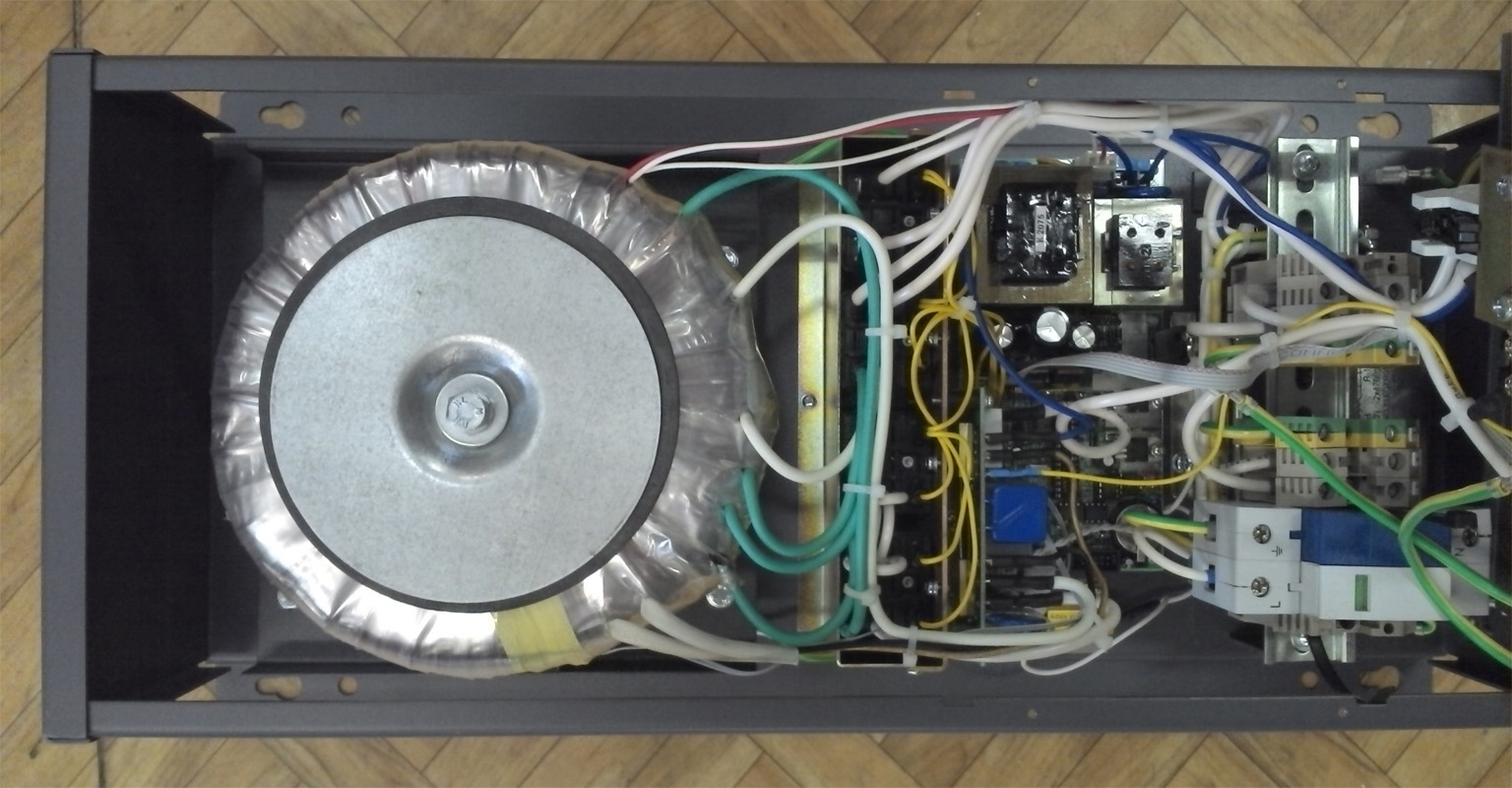
Relays in the stabilizer are installed by TycoElectronics RMC series with a rated current of 30 A, which is quite enough for switching 6 kVA load.
The stabilizer automatically turns off the output when the input level reaches 304 V. At the same time, the stabilizer itself withstands long-term voltage up to 420 V (i.e., if the linear voltage is accidentally applied to the stabilizer or “zero burning”, it will not fail, while protecting the load ).
The stabilizer has a built-in electronic thermal protection, which allows you to automatically turn off the stabilizer when overheating and to re-enable after it cools.
The SCM stabilizers were developed for power supply including communication facilities, therefore they incorporate a high-frequency filter (in the photo - under the terminal blocks) and surge protection modules (in the photo - to the left of the terminal blocks).

For particularly curious users, there is a version of stabilizers with an RS-232 connector for connecting to a computer, where with the help of special software you can view the current network settings, output, and the event log.
In addition, the stabilizer, similar to RESANTA stabilizers, is equipped with a built-in bypass circuit.
Total, we denote the positive and negative features of the stabilizers SCM:
1) Stabilizers keep declared rated power over the entire input voltage range
2) Stabilizers are composed of the main elements of fire safety and protection, as well as additional electronic means of protection.
3) The stabilizer will protect the connected equipment from long-term overvoltage, while not fail when the network voltage to 420 V.
4) A special algorithm for switching relays increases the service life of stabilizers.
5) In the stabilizer are installed the elements of filtration of the mains voltage and protection from surge overvoltages.
6) There are versions of stabilizers with an RS-232 port to provide local monitoring, or integrate it into a global monitoring network.
7) The sufficiently high cost is several times higher than the “Chinese” stabilizers and is comparable to the cost of the stabilizers of Russian manufacturing firms (Energy, Inteps, Stiel). The reasons lie in ensuring compliance with the requirements of GOST, a fairly high cost of labor, as well as the general situation of small industry in Russia, where the cost of components is much higher than in China.
In the light of the above, it should be noted that buying an AC voltage stabilizer requires not only chasing more power for less money, stabilization accuracy, or a wide range of operating voltages (using the RESANTA as an example, you can see the marketing work), but also take into account other important parameters that can and come to the fore.
Samples of fairly common RESANTA relay stabilizers, a Chinese stabilizer TDR-10000 of a little-known company, bought on an Alibaba and a Russian-made stabilizer of the SCM series were selected as a review product. Other types of stabilizers ( thyristor , motor-drive , etc.) were not taken for comparison, because, first, we compare what we have on hand, and second, their comparison can turn into another “holivar”. Each type of stabilizer has its own advantages and disadvantages. Choice is always a compromise.
The fact that stabilizers perform their main function is not questioned, otherwise they would not be sold - they all maintain the output voltage in a given range. Therefore, we will select the following comparison criteria: comments on the parameters; appearance; quality of installation and accessories; protection, electrical safety and fire safety, additional functions.
1. Voltage regulator RESANTA ASN-8000/1.
Notes on parameters:
Parameters of stabilizers can be found on the RESANTA website .The first thing that catches your eye when reading the instruction manual is a load characteristic. It turned out that, for example, for our stabilizer ASN-8000/1 at a voltage of less than 200 V, the permissible output power is linearly reduced from 8 kVA to 4 kVA. This unpleasantly surprised (and, in accordance with the instruction manual, the manufacturer imposes on the consumer the choice of a deliberately more powerful stabilizer, otherwise it is removed from the guarantee). Indeed, according to the standard (Clause 5.2 of GOST 13109-97), the maximum permissible deviation of the mains voltage from the nominal is 10% (198-242 V). Those. at a voltage of more than 200 V, the stabilizer is not particularly necessary (you can do with a power protective relay). And at a voltage of less than 200 V, you need to take into account the permissible power that is below the maximum. In the manual, this is due to the increase in the input current of the stabilizer. The only way to explain this in fact is the deliberately overestimation of the output power for advertising purposes, since this problem is solved by increasing the size of the autotransformer - and this is extra dimensions and money.
The second is regulation time. Sly manufacturers specify the regulation time as the relay contact time, and even then, the indicated 5 ms does not correspond to reality. The actual switching time of the relay (from the moment when the voltage is applied to the coil to contact closure) is not less than 7 ms for the relays of the best manufacturers: Omron, Tyco, Hongfa, TTI (at one time I accelerated from 15 ms to 4.5 ms to switch the polarized GRUNER relays applying an overvoltage control at the start of the switch - but this is extremely detrimental to the service life of the relay), plus the response time of the control system - for control of the actual voltage value, it is at least 3-5 ms (a quarter of the mains voltage).
Appearance:
The appearance of the stabilizers is practically the same as the Chinese counterparts, which suggests their origin (in the photo, the stabilizer of the previous version - even with electromechanical switch voltmeters).
')
The quality of installation and components:
Inside, stabilizers look quite acceptable and neat (oh, this unforgettable smell of Chinese rubber ... already distorts, and in an hour the head starts to hurt), except for fixing the printed circuit board at two points and electrolytic capacitors, which as always in Chinese products stand “who are in the forest who for firewood ”(the Russian Quality Control Department would not allow such installation).
Pumped up also installation of conductors to the relay. The installation was done by soldering, not quite neatly, but the main thing - it works.

Relays in the stabilizer are installed JQX-40F. The manufacturer on the case is not listed, but many manufacturers make such relays. The relays are rated at 40A, which is quite enough for 8 kVA load.
Protection, electrical safety and fire safety:
The stabilizers have thermal protection against overheating of the autotransformer, which is good news.No current measuring circuit was found in the stabilizers. From which it can be concluded that there is no automatic overload protection - there is only hope for the built-in automatic switch and protection against overheating. In addition, the principle of relay switching remains unknown: when a current passes through zero, zero voltage, or at an arbitrary point in time, the life of the relay depends on it.
The output protection against input voltage exceeding is declared by the manufacturer at the level of 260 V. Although the limit value of the voltage at which the stabilizer itself does not fail, remains unclear.
Upon further inspection of the viscera, it was found that the stabilizers do not contain any elements of filtration and protection against impulse overvoltages (GOST R 51992-2002).
In the powerful stabilizers applied forced cooling (not very effective, but sufficient). On the one hand, this facilitates the modes of operation of the stabilizer components, and on the other, it is an activated and noisy fan, which over time will require maintenance.
Additional functions:
Of the additional functions, it is possible to distinguish the presence of a bypass switch in more powerful models, which will allow to feed the load directly from the network when the stabilizer fails.In addition, the stabilizers display the value of the voltage at the input and output (switch instruments in previous models and digital indicators in the current on the market).
Summarizing, we can note the main features (both positive and negative) of the RESEARCH stabilizers:
1) You need to buy stabilizers with at least 40% power margin
2) Stabilizers are composed of the main elements of fire safety and protection
3) The stabilizer is likely to protect the connected equipment from long-term overvoltages, although it may also fail.
4) In the stabilizer there are no filtering elements of the mains voltage and elements of protection against surge overvoltages.
5) Stabilizers are incredibly cheap. In Russia, only one transformer for the same power as the RESANTA stabilizer costs half its price.
2. Voltage stabilizer TDR-10000 Chinese manufacturer.
The stabilizer was purchased in China and delivered by EMS (the same stabilizers can be found in Russia). The cost is 30% less than the RESANTA stabilizer.
Notes on parameters:
No, although there is no data on the dependence of the output power on the input voltage.Appearance:
A good appearance, except for the fact that during transportation the autotransformer bent the bottom of the case (it is thin and not designed for such loads).

The quality of installation and components:
When opening the casing, there was no limit to surprise (in the photo there is a view of the stabilizer as it arrived).
Apparently, there were not enough wires from the transformer, plus the bottom was dragged out.
The mounting of the printed circuit board and the installation of capacitors are similar to RESENTANT stabilizers.
Upon further examination, it turned out that in the stabilizer the “no-name” relays were installed, similar to the TR90 (TTI) or HF2150 (HONGFA) rated current 30A. Those. the maximum switching power of the relay is 6600 VA, there can be no talk of any declared 10,000 VA.
Therefore, a further description of the stabilizer is meaningless.
The stabilizer was turned on, it looked like the input and output voltage shows (quite accurately), turned off and removed away.
Conclusion - no need to chase for cheap.
3. Voltage stabilizers of Russian production SCm.
In the presence of a stabilizer SCM-6000, so the conversation will go about it.
Notes on parameters:
None.The stabilizer provides its parameters , including the declared rated output power in the entire supply voltage range (the lower range is slightly higher than the RESPECT stabilizers for the same reason for increasing the input current).
Appearance:
The body of the stabilizer is original (in the style of the Soviet industry), markedly different from all those on the market, which allows both horizontal placement and wall mounting in any position.
The quality of installation and components:
Installation of the stabilizer is made in accordance with GOST and OST. All wiring connections are detachable, with the use of cable lugs of various types. The density of installation is quite high, there is practically no free space in the case.
Relays in the stabilizer are installed by TycoElectronics RMC series with a rated current of 30 A, which is quite enough for switching 6 kVA load.
Protection, electrical safety and fire safety:
In contrast to the above, in the stabilizers SCM has a built-in node control current load. Due to this, besides the built-in input circuit breaker, the function of automatic overload control is implemented. And most importantly, the switching of the stabilizer relay is carried out at the moment the load current passes through zero - this allows to minimize the formation of an arc on the relay contacts. Consequently, the relay resource is increased several times.The stabilizer automatically turns off the output when the input level reaches 304 V. At the same time, the stabilizer itself withstands long-term voltage up to 420 V (i.e., if the linear voltage is accidentally applied to the stabilizer or “zero burning”, it will not fail, while protecting the load ).
The stabilizer has a built-in electronic thermal protection, which allows you to automatically turn off the stabilizer when overheating and to re-enable after it cools.
The SCM stabilizers were developed for power supply including communication facilities, therefore they incorporate a high-frequency filter (in the photo - under the terminal blocks) and surge protection modules (in the photo - to the left of the terminal blocks).

Additional functions:
Stabilizers are equipped with LED display. Apparently, the manufacturer decided that the consumer doesn’t need to know what the voltage at the input and output is, but the stabilizer will notify with a sound and light alarm if something is wrong.For particularly curious users, there is a version of stabilizers with an RS-232 connector for connecting to a computer, where with the help of special software you can view the current network settings, output, and the event log.
In addition, the stabilizer, similar to RESANTA stabilizers, is equipped with a built-in bypass circuit.
Total, we denote the positive and negative features of the stabilizers SCM:
1) Stabilizers keep declared rated power over the entire input voltage range
2) Stabilizers are composed of the main elements of fire safety and protection, as well as additional electronic means of protection.
3) The stabilizer will protect the connected equipment from long-term overvoltage, while not fail when the network voltage to 420 V.
4) A special algorithm for switching relays increases the service life of stabilizers.
5) In the stabilizer are installed the elements of filtration of the mains voltage and protection from surge overvoltages.
6) There are versions of stabilizers with an RS-232 port to provide local monitoring, or integrate it into a global monitoring network.
7) The sufficiently high cost is several times higher than the “Chinese” stabilizers and is comparable to the cost of the stabilizers of Russian manufacturing firms (Energy, Inteps, Stiel). The reasons lie in ensuring compliance with the requirements of GOST, a fairly high cost of labor, as well as the general situation of small industry in Russia, where the cost of components is much higher than in China.
In the light of the above, it should be noted that buying an AC voltage stabilizer requires not only chasing more power for less money, stabilization accuracy, or a wide range of operating voltages (using the RESANTA as an example, you can see the marketing work), but also take into account other important parameters that can and come to the fore.
Source: https://habr.com/ru/post/188748/
All Articles